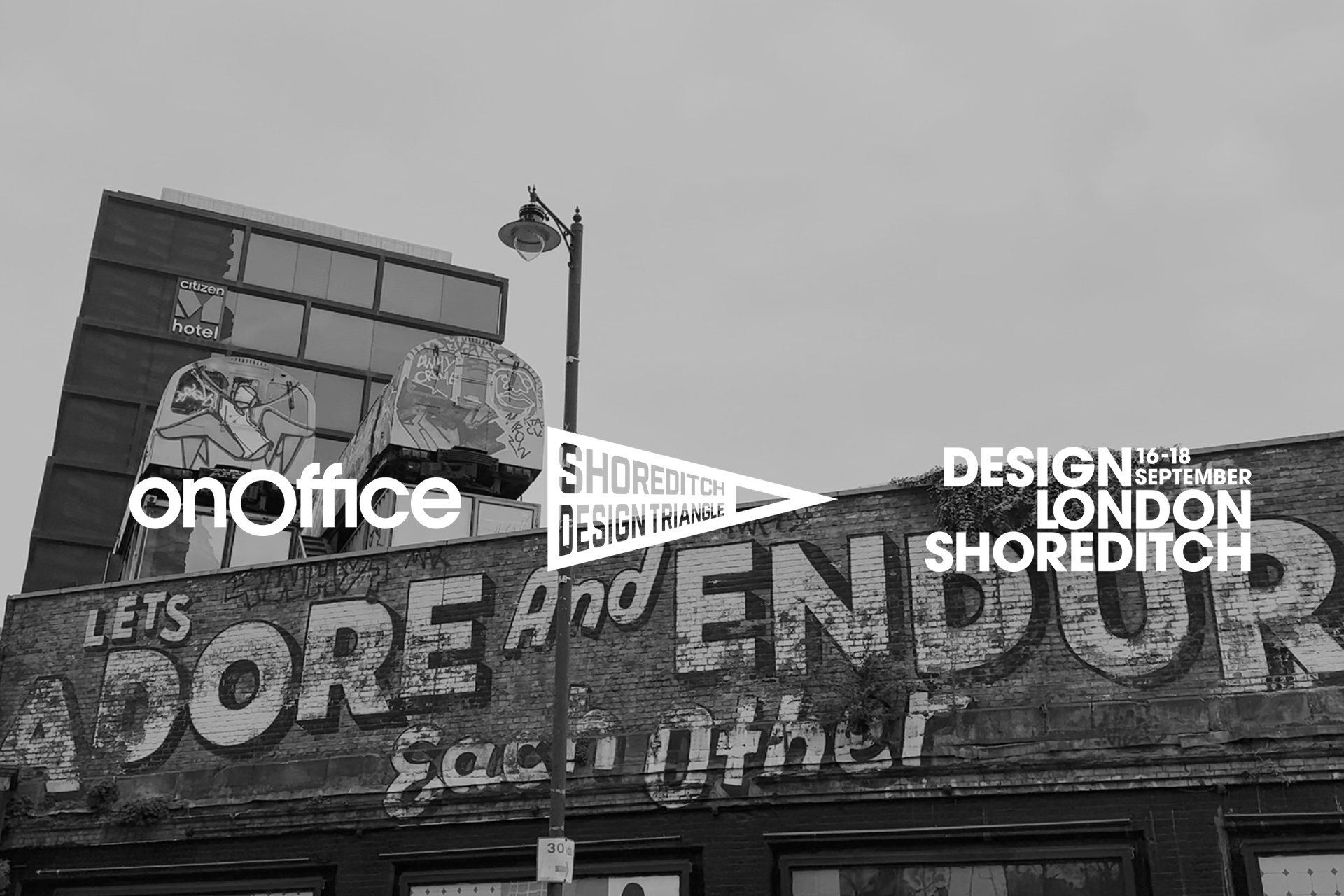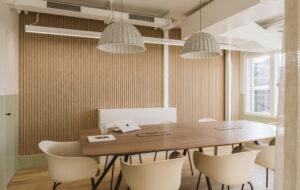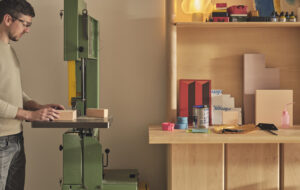 A cantilevered glass box hangs over the showrooms’ entrance|G-Star’s hulking Amsterdam HQ is highly visible from the motorway it abuts|The interiors’ austere grey palette meets with G-Star’s wider branding|Creative spaces have been separated from the administrative functions|G-Star’s ‘reimagined’ Jean Prouvé range for Vitra appears in the boardroom|Temporary partitions help to define the otherwise uninterrupted working areas|Staggered floorplates and double-height spaces encourage interaction||
A cantilevered glass box hangs over the showrooms’ entrance|G-Star’s hulking Amsterdam HQ is highly visible from the motorway it abuts|The interiors’ austere grey palette meets with G-Star’s wider branding|Creative spaces have been separated from the administrative functions|G-Star’s ‘reimagined’ Jean Prouvé range for Vitra appears in the boardroom|Temporary partitions help to define the otherwise uninterrupted working areas|Staggered floorplates and double-height spaces encourage interaction||
Dutch fashion label G-Star Raw‘s new HQ in Amsterdam makes no bones about the fact that it’s the architectural embodiment of the brand, renowned for rugged but fashion-conscious clothing inspired by military uniforms and workwear. Designed by Dutch starchitects OMA, the building is located in the city’s primarily industrial Zuid-Oost area, which Marina Cogliani, one of the project’s architects, describes as “an up-and-coming residential and working district for Amsterdam’s creative industries”.
At first sight, the fashion label’s HQ – a new-build designed, says Cogliani, “to consolidate G-Star Raw’s disparate facilities, previously spread across five buildings, into a single building that aims to stimulate interaction between its various departments” – looks corporate, monolithic, almost bunker-like. You could even describe it as a 21st-century take on brutalism, given its hulking concrete frame.
Occupied by about 500 staff – a mix of designers, interior designers, marketing and sales people, managers and audio-visual technicians – the building is clearly a branding exercise. The concrete is in a murky, storm-cloud grey tone that visually corresponds with the palette of industrial-chic, dirty greys and blues that G-Star’s denim jeans and jackets mainly come in. The 140m-long, 27,500sq m building – raised on a plinth and approached via wide steps – is located beside Amsterdam’s A10 motorway, and the traffic speeding past it can’t fail to notice the massive logo on one facade. Yet the building is more subtle than this unavoidable logo and its austere concrete frame suggests.
The latter wraps around a row of glass boxes containing the company’s creative departments and so breaks up an otherwise uniform-looking exterior. “Anyone driving past the building can look into its fully transparent nucleus and see the creative activity going on inside,” says Cogliani. In fact, one unexpected aspect of the project is its theatricality.
Indeed, despite the predominantly opaque exterior of OMA’s design, the architects like to talk up the fact, that its core is visible through this glass facade. There are huge sliding doors, which can be fully opened or closed; sourced from an aircraft hangar manufacturer, they make this part of the building both resemble an aeronautical structure and give it an authentically industrial quality. More generally, OMA has played on the stark contrast in the building between opacity and transparency, a key characteristic of the project.
This contrast isn’t simply about aesthetics: the enclosed and glass-fronted parts of the building have completely different functions. While the glass boxes are occupied by the company’s creative departments (including fashion design, interior design, styling, merchandising and marketing and PR) the concrete frame, referred to as the Ring, mainly houses all its amenities, including a car park for 250 cars, parking spaces for scooters, electric cars and bikes, a warehouse, kitchen, loading and unloading bays and the company’s legal, HR, finance and administration departments. Once you know this, the building’s hierarchy becomes apparent – the glass boxes housing creative, relatively intellectual activities are considered more important than those containing the practical facilities. This impression is reinforced by the fact that, while G-Star wants the outside world to be able to look into the former – almost to a voyeuristic degree – it wishes to conceal the latter from public view.
One of the glass boxes is cantilevered, projecting outwards to help break up the building’s monolithic exterior. “This box, which hangs above the building’s main entrance, houses showrooms which buyers and other business guests can visit,” says Cogliani. “From here visitors get a view of the entire internal dynamic of the building thanks to its staggered floorplates and double-height spaces, without being able to invade it.”
It’s in this area that the building’s theatricality is particularly marked. And it’s here that a kind of voyeurism is most openly encouraged. It would be interesting to know how employees feel about visitors watching them from a distance; are they a little unnerved? The building’s lobby inside the front entrance is designed to impress visitors further, boasting a bespoke reception desk created by Marc Newson (Newson also designs a clothing range for G-Star).
The glass boxes moreover fulfil one of the demands of OMA’s brief – that the building be flooded with natural daylight. Incidentally, this is one of various measures taken to make it sustainable. “Natural ventilation is guaranteed throughout the building’s full
height,” Cogliani points out. “Solar heat gain and glare from sunlight are reduced by solar-control glazing and blinds on the south facade.” There are no green, landscaped areas – perhaps because they would detract from the building’s uncompromisingly industrial aesthetic – although there are two outdoor terraces.
While visitors may have limited access to the building’s interior, the space is designed to be as transparent as possible for employees. Having decided to house all its staff under one roof in its new HQ, G-Star is keen to encourage plenty of interaction, made possible by “staggered floorplates, split-level areas and large, open-plan spaces in which transparent partitions that offer clear sightlines can be installed whenever needed,” according to Cogliani. “Breakout spaces on landings midway between floors and staircases encourage conversation between staff.”
One key feature of the project is what G-Star calls the building’s Raw Space. This a flexible, multi-purpose area, which is housed partly within the building and partly spilling out on to the plinth. It provides an arena for a wide variety of events, including fashion shows and parties. “It’s up to G-Star to decide how to use it,” says Cogliani. “It can be used for putting on PR-related events, for example, showcasing such events to those driving past, thereby presenting the dynamic, ever-changing face of
G-Star to the outside world.”
The areas these events are held in aren’t strictly demarcated: “Fashion shows and other events have been held in the car park too, as demonstrated by one successful customer event last June,” adds Cogliani.
Overall, G-Star’s HQ sends out conflicting messages – it communicates the brand’s aesthetic in unambiguous terms, but it likes to be ambiguous in other ways, both shielding itself from view and teasingly piquing the curiosity of the outside world.
























